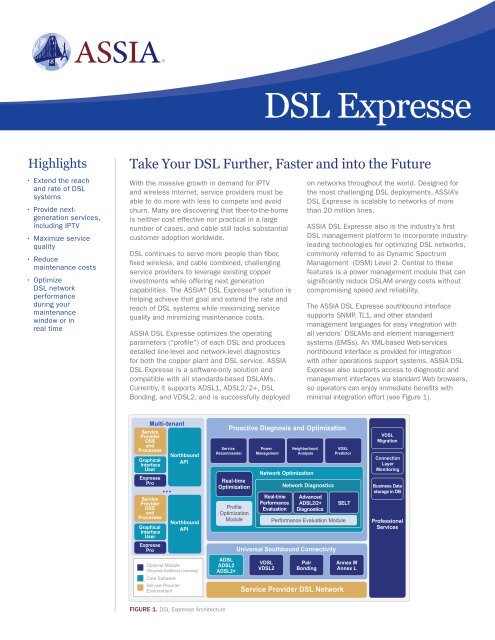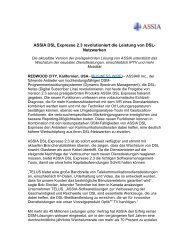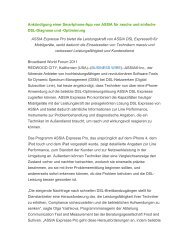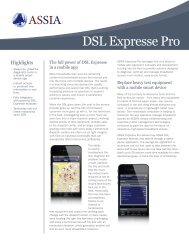DSL Expresse Product Brief - ASSIA Inc.
DSL Expresse Product Brief - ASSIA Inc.
DSL Expresse Product Brief - ASSIA Inc.
You also want an ePaper? Increase the reach of your titles
YUMPU automatically turns print PDFs into web optimized ePapers that Google loves.
Highlights<br />
• Extend the reach<br />
and rate of <strong>DSL</strong><br />
systems<br />
• Provide nextgeneration<br />
services,<br />
including IPTV<br />
• Maximize service<br />
quality<br />
• Reduce<br />
maintenance costs<br />
• Optimize<br />
<strong>DSL</strong> network<br />
performance<br />
during your<br />
maintenance<br />
window or in<br />
real time<br />
Take Your <strong>DSL</strong> Further, Faster and into the Future<br />
With the massive growth in demand for IPTV<br />
and wireless Internet, service providers must be<br />
able to do more with less to compete and avoid<br />
churn. Many are discovering that fiber-to-the-home<br />
is neither cost effective nor practical in a large<br />
number of cases, and cable still lacks substantial<br />
customer adoption worldwide.<br />
<strong>DSL</strong> continues to serve more people than fiber,<br />
fixed wireless, and cable combined, challenging<br />
service providers to leverage existing copper<br />
investments while offering next generation<br />
capabilities. The <strong>ASSIA</strong>®<strong>DSL</strong> <strong>Expresse</strong>®solution is<br />
helping achieve that goal and extend the rate and<br />
reach of <strong>DSL</strong> systems while maximizing service<br />
quality and minimizing maintenance costs.<br />
<strong>ASSIA</strong> <strong>DSL</strong> <strong>Expresse</strong> optimizes the operating<br />
parameters (“profile”) of each <strong>DSL</strong> and produces<br />
detailed line-level and network-level diagnostics<br />
for both the copper plant and <strong>DSL</strong> service. <strong>ASSIA</strong><br />
<strong>DSL</strong> <strong>Expresse</strong> is a software-only solution and<br />
compatible with all standards-based <strong>DSL</strong>AMs.<br />
Currently, it supports A<strong>DSL</strong>1, A<strong>DSL</strong>2/2+, <strong>DSL</strong><br />
Bonding, and V<strong>DSL</strong>2, and is successfully deployed<br />
Multi-tenant<br />
Service<br />
Provider<br />
OSS<br />
and<br />
Processes<br />
Graphical<br />
Interface<br />
User<br />
<strong>Expresse</strong><br />
Pro<br />
Service<br />
Provider<br />
OSS<br />
and<br />
Processes<br />
Graphical<br />
Interface<br />
User<br />
<strong>Expresse</strong><br />
Pro<br />
...<br />
Optional Module<br />
(Requires Additional Licensing)<br />
Core Software<br />
Service Provider<br />
Environment<br />
Northbound<br />
API<br />
Northbound<br />
API<br />
FIGURE 1. <strong>DSL</strong> <strong>Expresse</strong> Architecture<br />
Proactive Diagnosis and Optimization<br />
Service<br />
Recommender<br />
Real-time<br />
Optimization<br />
Profile<br />
Optimization<br />
Power<br />
Management<br />
Network Optimization<br />
Real-time<br />
Performance<br />
Evaluation<br />
Neighborhood V<strong>DSL</strong><br />
Analysis<br />
Predictor<br />
Network Diagnostics<br />
Advanced<br />
A<strong>DSL</strong>2/2+ SELT<br />
Diagnostics<br />
Module Performance Evaluation Module<br />
A<strong>DSL</strong><br />
A<strong>DSL</strong>2<br />
A<strong>DSL</strong>2+<br />
<strong>DSL</strong> <strong>Expresse</strong><br />
Universal Southbound Connectivity<br />
V<strong>DSL</strong><br />
V<strong>DSL</strong>2<br />
Pair<br />
Bonding<br />
Service Provider <strong>DSL</strong> Network<br />
on networks throughout the world. Designed for<br />
the most challenging <strong>DSL</strong> deployments, <strong>ASSIA</strong>’s<br />
<strong>DSL</strong> <strong>Expresse</strong> is scalable to networks of more<br />
than 20 million lines.<br />
<strong>ASSIA</strong> <strong>DSL</strong> <strong>Expresse</strong> also is the industry’s first<br />
<strong>DSL</strong> management platform to incorporate industry-<br />
leading technologies for optimizing <strong>DSL</strong> networks,<br />
commonly referred to as Dynamic Spectrum<br />
Management (DSM) Level 2. Central to these<br />
features is a power management module that can<br />
significantly reduce <strong>DSL</strong>AM energy costs without<br />
compromising speed and reliability.<br />
The <strong>ASSIA</strong> <strong>DSL</strong> <strong>Expresse</strong> southbound interface<br />
supports SNMP, TL1, and other standard<br />
management languages for easy integration with<br />
all vendors’ <strong>DSL</strong>AMs and element management<br />
systems (EMSs). An XML-based Web-services<br />
northbound interface is provided for integration<br />
with other operations support systems. <strong>ASSIA</strong> <strong>DSL</strong><br />
<strong>Expresse</strong> also supports access to diagnostic and<br />
management interfaces via standard Web browsers,<br />
so operators can enjoy immediate benefits with<br />
minimal integration effort (see Figure 1).<br />
Annex M<br />
Annex L<br />
V<strong>DSL</strong><br />
Migration<br />
Connection<br />
Layer<br />
Monitoring<br />
Business Data<br />
storage in DB<br />
Professional<br />
Services
<strong>ASSIA</strong> <strong>DSL</strong><br />
<strong>Expresse</strong><br />
automatically<br />
configures<br />
all lines in<br />
the network<br />
to the highest<br />
possible<br />
stable speed.<br />
<strong>ASSIA</strong> <strong>DSL</strong> <strong>Expresse</strong> Functions<br />
AUTOMATIC RE-PROFILING AND REPAIR<br />
<strong>DSL</strong> profiles are complex and include many factors<br />
that constantly interact, such as power levels and<br />
margins, bit rates, interleaving, and forward error<br />
correction schemes. Operators have traditionally<br />
defined a limited number of profiles for their network<br />
and applied them to their <strong>DSL</strong>s manually using<br />
simple heuristics such as loop length. Each loop<br />
in the network is different, however, and often the<br />
result of the traditional process is that lines are<br />
either under-provisioned by being programmed to<br />
a speed lower than what they can support, or over-<br />
provisioned by being programmed to a speed that is<br />
too high to maintain stability. Under-provisioned lines<br />
lead to lost revenue opportunities for higher-speed<br />
services or for applications such as IPTV. Overprovisioned<br />
lines lead to higher maintenance costs<br />
from customer complaints and high churn rates.<br />
Based on the <strong>DSL</strong> operator’s service tiers and<br />
quality-of-service targets, <strong>ASSIA</strong> <strong>DSL</strong> <strong>Expresse</strong><br />
automatically configures all lines in the network<br />
to the highest possible stable speed. <strong>ASSIA</strong><br />
<strong>DSL</strong> <strong>Expresse</strong> is run proactively on all lines in an<br />
operator’s network on a daily basis. It can also<br />
be run reactively in the case of newly provisioned<br />
lines, or at the request of technical or customer<br />
support personnel.<br />
Figure 2 shows the results of automatic re-<br />
profiling in a commercial network with A<strong>DSL</strong>1 and<br />
A<strong>DSL</strong>2/2+ equipment. Downstream rates are<br />
shown on the left. Stability appears on the right,<br />
characterized by a combination of code violations<br />
in a 15-minute period, and modem retrains in a<br />
12-hour period. The light and dark blue stability<br />
categories are suitable for IPTV.<br />
In these real-life results, <strong>ASSIA</strong> <strong>DSL</strong> <strong>Expresse</strong><br />
increased the fraction of users that could receive<br />
speeds in excess of 10 Mbps from roughly 5<br />
Downstream Rates<br />
Before <strong>Expresse</strong><br />
1% 1% 3%<br />
19%<br />
47%<br />
29%<br />
Downstream Rates<br />
After <strong>Expresse</strong><br />
18%<br />
11%<br />
12%<br />
Above 14 Mbps<br />
12~14 Mbps<br />
10~12 Mbps<br />
7~10 Mbps<br />
5~7 Mbps<br />
Below 5 Mbps<br />
21%<br />
14%<br />
24%<br />
percent of the network to nearly 60 percent of the<br />
network. At the same time, the fraction of users<br />
with poor quality IPTV services was reduced by<br />
nearly 75 percent, from 37 percent of the network<br />
to 9 percent of the network.<br />
DIAGNOSTICS<br />
<strong>ASSIA</strong> <strong>DSL</strong> <strong>Expresse</strong> analyzes data collected<br />
from <strong>DSL</strong>AMs and EMSs to produce powerful<br />
and unique <strong>DSL</strong> and physical layer performance<br />
diagnostics (see Table 1 on last page).<br />
These diagnostics help improve customer<br />
care and increase technical staff efficiency,<br />
significantly reducing the number of steps<br />
required to restore service, and eliminating or<br />
reducing expensive technician visits through<br />
improved problem localization.<br />
<strong>ASSIA</strong> <strong>DSL</strong> <strong>Expresse</strong>’s powerful neighborhood<br />
analysis feature quickly separates customer<br />
premises problems from outside plant problems,<br />
enabling <strong>DSL</strong> operators to dispatch the correct<br />
repair personnel and to proactively plan plant<br />
upgrade or repair services. Unlike legacy<br />
diagnostic approaches, <strong>ASSIA</strong> <strong>DSL</strong> <strong>Expresse</strong><br />
advanced <strong>DSL</strong>-centric diagnostics do not interrupt<br />
the customer’s <strong>DSL</strong> service. The diagnostics<br />
are easily accessible by all authorized operator<br />
personnel using standard Web browsers, such as<br />
Firefox, Safari or IE via the Web client interface.<br />
In addition, the <strong>ASSIA</strong> <strong>DSL</strong> <strong>Expresse</strong> northbound<br />
interface provides a standard XML-based<br />
mechanism for distributing diagnostic data to<br />
other OSS systems.<br />
<strong>DSL</strong> <strong>Expresse</strong> also takes advantage of SELT<br />
capabilities available in certain <strong>DSL</strong>AMs to locate<br />
the fault identified by its diagnostics engine.<br />
The combination of <strong>DSL</strong> <strong>Expresse</strong> advanced<br />
diagnostics and SELT greatly improves the<br />
accuracy of issue detection and location (see<br />
Table 1)<br />
13%<br />
16%<br />
Stability Before<br />
<strong>Expresse</strong><br />
8%<br />
23%<br />
40%<br />
29%<br />
Very Stable<br />
Stable<br />
Unstable<br />
Very Unstable<br />
Extremely Unstable<br />
Stability After<br />
<strong>Expresse</strong><br />
5%<br />
3% 1%<br />
62%
Diagnostics<br />
are easily<br />
accessible by<br />
all authorized<br />
personnel<br />
using<br />
standard Web<br />
browsers.<br />
REAL-TIME DIAGNOSTICS AND OPTIMIZATION<br />
This state-of-the-art capability can easily be<br />
triggered by the field technician while on dispatch,<br />
and confirms in real time that the problem has<br />
actually been fixed and that <strong>DSL</strong> performance<br />
is restored or enhanced. The result is an<br />
improvement in technician performance in the<br />
field and a reduction in the number of repeat calls<br />
and dispatches.<br />
The Real Time Performance Evaluation module<br />
requires supplementary licensing and may be<br />
integrated through <strong>ASSIA</strong> professional services into<br />
the service provider’s Interactive Voice Response<br />
(IVR) systems. This enables intelligent triage to<br />
level-2 <strong>DSL</strong> technicians when an actual physical<br />
layer fault is detected by <strong>ASSIA</strong> <strong>DSL</strong> <strong>Expresse</strong>.<br />
This powerful, real-time capability helps reduce<br />
the unnecessary level-1 manual investigation and<br />
increases customer satisfaction.<br />
Like diagnostics, real-time optimization is an<br />
optional license which allows the service provider<br />
to reconcile the real-time needs of a call center<br />
agent or a technician with the longer span of data<br />
required for a full optimization. This feature allows<br />
partial realization of the profile optimization value<br />
proposition, helping to reduce dispatch costs and<br />
quickly improve line performance.<br />
18.50%<br />
22.60%<br />
6.70%<br />
52.20%<br />
SERVICE RECOMMENDER<br />
Using the <strong>DSL</strong> operator’s service tiers, the Service<br />
Recommender analyzes the characteristics of<br />
all <strong>DSL</strong>s in the network to identify lines that can<br />
support a higher level of service than that for<br />
which they are currently provisioned (and hence<br />
produce higher Average Revenue per User).<br />
The Service Recommender software module<br />
lets the operator target new service offerings<br />
to specific subscriber groups, whose lines can<br />
sustain the higher grade of service. This helps<br />
improve marketing returns and sales costs and<br />
can lead to higher customer satisfaction with<br />
reduced churn.<br />
Figure 3 illustrates the performance differences<br />
between a traditional loop qualification system<br />
and the <strong>DSL</strong> <strong>Expresse</strong> Service Recommender<br />
software module. The section in gold indicates the<br />
portion that the loop qualification tool erroneously<br />
identified as capable of carrying the 7 Mbps <strong>DSL</strong><br />
service, causing customer frustration and high<br />
opex for the service provider to manage. The<br />
section in dark blue identifies the portion of lines<br />
which have been marked as not qualifying for the<br />
same 7 Mbps service and could actually generate<br />
supplementary revenue for the service provider.<br />
Service Recommender requires additional<br />
licensing, and results can be viewed with a<br />
Web browser or accessed through operations<br />
support systems via the <strong>ASSIA</strong> <strong>DSL</strong> <strong>Expresse</strong><br />
northbound interface.<br />
Population of lines the Prequalication<br />
tool properly disqualied<br />
Population of lines the Prequalication<br />
tool wrongly disqualied<br />
Population of lines the Prequalication<br />
tool wrongly qualied<br />
Population of lines the Prequalication<br />
tool properly qualied<br />
<strong>ASSIA</strong> <strong>DSL</strong> <strong>Expresse</strong> identied more than 25% of lines that had been improperly<br />
prequalied by traditional methods<br />
FIGURE 3. Performance comparison between traditional loop qualification systems and <strong>DSL</strong> <strong>Expresse</strong> Service Recommender for <strong>ASSIA</strong> customer
Contact<br />
<strong>ASSIA</strong> today<br />
+1.650.654.3400<br />
or email<br />
sales@assia-inc.com<br />
333 Twin Dolphin Drive<br />
Redwood City, CA 94065<br />
Tel: +1-650-654-3400<br />
Fax: +1-650-654-3404<br />
www.assia-inc.com<br />
© 2012 <strong>ASSIA</strong>, <strong>Inc</strong>orporated.<br />
All rights reserved.<br />
<strong>ASSIA</strong>, the <strong>ASSIA</strong> logo, and<br />
<strong>DSL</strong> <strong>Expresse</strong> are registered<br />
trademarks of <strong>ASSIA</strong>, <strong>Inc</strong>orporated.<br />
All other product names, company<br />
names, logos, and trademarks<br />
are used herein for identification<br />
purposes only and are the property<br />
of their respective companies.<br />
Rev 071312 P/N MC-E1-0103-01-04<br />
Makes Economic Sense Today and Tomorrow<br />
<strong>ASSIA</strong> <strong>DSL</strong> <strong>Expresse</strong> greatly improves the<br />
economics of <strong>DSL</strong> operations. Revenues are<br />
improved through reductions in churn and<br />
increased sales opportunities for higher-tier<br />
services and bandwidth-intensive applications like<br />
IPTV. Operating costs are reduced due to fewer<br />
customer calls and reduced technician dispatches.<br />
<strong>ASSIA</strong> <strong>DSL</strong> <strong>Expresse</strong> can deliver these benefits by<br />
extending <strong>DSL</strong>AM reach, automating the repair/<br />
re-profiling of <strong>DSL</strong>s, improving the efficiency<br />
of customer care operations, and improving<br />
the service provider’s ability to manage vendor<br />
relationships through network-level analysis.<br />
Furthermore, capital costs can be reduced<br />
through extensions in the <strong>DSL</strong>AM rate/reach<br />
curve that extend the usefulness of existing<br />
<strong>DSL</strong>AMs in the network.<br />
One of the key hurdles to rolling out faster <strong>DSL</strong><br />
technologies is economics. Deploying more<br />
<strong>DSL</strong>AMs across the network and closer to the<br />
subscriber is usually a costly proposal and<br />
something which rarely can be distributed between<br />
service providers without giving the incumbent<br />
LOOP DIAGNOSTICS NOISE ANALYSIS CONNECTION STATISTICS NETWORK PERFORMANCE<br />
✓ Loop Length<br />
✓ Short/Open Circuit<br />
✓ Bridged Taps<br />
with Length<br />
✓ Bad Splice<br />
✓ Crossed Pair<br />
✓ MDF mis-wiring<br />
✓ Water in cable<br />
✓ Loop unbalance/<br />
untwisted wiring<br />
✓ Missing Micro lter<br />
detection<br />
✓ Fault location<br />
(SELT required)<br />
✓ <strong>DSL</strong> Crosstalk<br />
✓ AM Noise<br />
✓ T1/E1 Crosstalk<br />
✓ ISDN Crosstalk<br />
TABLE 1. <strong>DSL</strong> <strong>Expresse</strong> Diagnostics (partial list)<br />
✓ Maximum Data Rate<br />
✓ Code Violation Rates<br />
✓ Retrain Rates<br />
✓ Power and Margins<br />
✓ Impulse noise ✓ Line Stability level<br />
✓ H<strong>DSL</strong> Crosstalk ✓ MABR after Removal<br />
of Impairment<br />
✓ High Power noise<br />
✓ High Power noise<br />
at high frequency<br />
an unfair advantage, and thereby eliminating a<br />
competitive environment. <strong>ASSIA</strong> offers the option<br />
of virtually slicing the overall <strong>DSL</strong> network down<br />
to the port level via multi-tenancy management.<br />
This not only allows ISPs to share the hardware<br />
infrastructure and outside plant investments<br />
but also enables them to introduce the latest<br />
<strong>DSL</strong> technologies, such as vectoring to deliver<br />
100Mbps reliably to the house, through managing<br />
a mixed-binder environment. In addition, a<br />
regulatory body can be established as a “super<br />
user” to verify the quality of the networks<br />
within its jurisdiction and potentially enforce<br />
performance/coexistence rules through the active<br />
use of this platform.<br />
Realizable improvements depend on the details<br />
of the operator’s business and network. For that<br />
reason, <strong>ASSIA</strong> routinely works with operators to<br />
develop in-depth economic analyses of <strong>ASSIA</strong><br />
<strong>DSL</strong> <strong>Expresse</strong> tailored to a particular network or<br />
business model. Contact <strong>ASSIA</strong> today to arrange<br />
a trial of <strong>ASSIA</strong> <strong>DSL</strong> <strong>Expresse</strong> in your network, and<br />
start taking your existing <strong>DSL</strong> infrastructure to a<br />
whole new level.<br />
✓ DS/US variation<br />
✓ Rate, QoS Analyses<br />
✓ Vendor Comparisons<br />
✓ Neighborhood Analysis<br />
✓ CPE performances<br />
✓ <strong>DSL</strong>AM performances<br />
✓ Highest /Lowest<br />
MABR percentile








